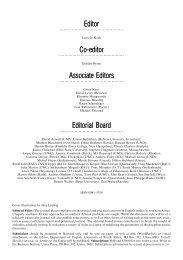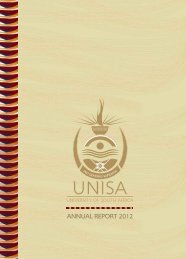Download the Annual report 2011 - Unisa
Download the Annual report 2011 - Unisa
Download the Annual report 2011 - Unisa
You also want an ePaper? Increase the reach of your titles
YUMPU automatically turns print PDFs into web optimized ePapers that Google loves.
eral disability awareness campaigns for staff at <strong>the</strong> university.<br />
While <strong>the</strong> physical infrastructure at <strong>the</strong> university<br />
is not yet optimally conducive to supporting staff with<br />
disabilities, steps are taken with all new buildings to ensure<br />
appropriate accommodation. However, <strong>Unisa</strong> has<br />
some very old infrastructure, and <strong>the</strong> refurbishment of<br />
existing buildings is an expensive initiative, but notwithstanding<br />
<strong>the</strong> costs, <strong>the</strong> matter is receiving attention and<br />
is part of <strong>the</strong> institutional Estates Plan. The employment<br />
equity compliance review 2008–<strong>2011</strong> was finalised and<br />
challenges have been highlighted to be addressed in <strong>the</strong><br />
2012–2014 Employment Equity Plan.<br />
<strong>Unisa</strong> is engaged with a very exciting project to analyse<br />
all policies and <strong>the</strong> workforce profile to assess its adherence<br />
to employment equity best practice standards. The<br />
outcomes will also be factored in to <strong>the</strong> 2012–2014 Employment<br />
Equity Plan.<br />
New organisational structure<br />
A significant focus of <strong>Unisa</strong>’s transformation journey has<br />
been on <strong>the</strong> areas of teaching, research, education, science<br />
and technology, which needed an injection of newness<br />
that would bring to <strong>the</strong> fore <strong>the</strong> necessary spirit of<br />
innovation. With this in mind, in <strong>2011</strong> we adopted a new<br />
institutional structure which included a separate College<br />
of Education 12 and three new portfolios of Teaching and<br />
Learning, Research and Innovation 13 and Institutional Development.<br />
Adequacy of staffing levels<br />
<strong>Unisa</strong> needed to address escalating HR costs while continuing<br />
to ensure <strong>the</strong> adequacy of staff provisioning. Accordingly,<br />
<strong>the</strong> decision was taken to prioritise <strong>the</strong> human<br />
resources in line with <strong>the</strong> university’s mandate and core<br />
business. In order to ensure that <strong>the</strong>re are adequate academic<br />
resources, and to ensure <strong>the</strong> necessary agility to<br />
accommodate changes in <strong>the</strong> PQM and <strong>the</strong> nature of<br />
<strong>the</strong> student compliment, a 70/30 principle (70% permanent<br />
and 30% contract appointments) was introduced.<br />
This was used as a guideline in 2010 and it was<br />
formally implemented during <strong>the</strong> <strong>2011</strong> HR planning<br />
process. Fur<strong>the</strong>r, during <strong>2011</strong> a gain of 10% was <strong>report</strong>ed<br />
regarding <strong>the</strong> filling/appointment in academic<br />
positions and 7% in <strong>the</strong> primary support positions which<br />
are essential in terms of our ODL nature. This gain was<br />
at <strong>the</strong> expense of <strong>the</strong> institutional support where 9%<br />
fewer positions were filled compared to 2010. Addition-<br />
UNISA ANNUAL REPORT <strong>2011</strong><br />
| 33 |<br />
ally, <strong>the</strong> time taken to fill vacant positions showed an improvement<br />
of 33%. This aspect impacts on <strong>the</strong> availability<br />
of resources within <strong>the</strong> university. The initiatives will<br />
be fur<strong>the</strong>r enhanced by <strong>the</strong> utilisation of technology in<br />
<strong>the</strong> future.<br />
Environmental sustainability<br />
Being an engaged and relevant institution also implies<br />
maintaining our relevance in <strong>the</strong> global context, and, in<br />
line with strategic Goal 6, I emphasised in my inaugural<br />
address all forms of sustainability, including <strong>the</strong> global<br />
groundswell of concern for <strong>the</strong> sustainability of our<br />
planet, <strong>the</strong> systems which drive it and <strong>the</strong> people who<br />
inhabit it. As a result, <strong>2011</strong> saw <strong>Unisa</strong> building upon <strong>the</strong><br />
foundation laid in previous years. <strong>Unisa</strong> has committed<br />
to embracing and embedding an ethos and practice of<br />
sustainability in all its activities, and I have taken <strong>the</strong> step<br />
to place <strong>the</strong> monitoring and oversight function directly<br />
in my own office, as our ethical mandate and commitment<br />
to <strong>the</strong> United Nations Global Compact (UNGC)<br />
akes this a non-negotiable priority. A number of significant<br />
initiatives have been undertaken that demonstrate<br />
<strong>the</strong> growing commitment to comprehensive and concrete<br />
support for sustainability at <strong>Unisa</strong>. The university<br />
is favourably capacitated in its sustainability endeavours<br />
by <strong>the</strong> active and engaged support of <strong>the</strong> Council. The<br />
staff are equally responsive and we will begin a plan of<br />
action to ensure that our students will also soon be taking<br />
<strong>the</strong> necessary lead in this direction.<br />
However, in <strong>2011</strong> our activities were more about raising<br />
awareness and supporting current and new quick-win<br />
initiatives in <strong>the</strong> area of environmental sustainability.<br />
Going forward, <strong>the</strong> university will develop a consolidated<br />
comprehensive plan under <strong>the</strong> gaze of Council, as <strong>the</strong><br />
Environmental Sustainability Policy (which will be approved<br />
in 2012) is submitted along with an operational<br />
plan that sets clear deadlines of achievement.<br />
As a signatory to <strong>the</strong> UNGC we have been engaged in<br />
a systematic process of embedding its ten principles<br />
across all university activities. We have also begun a successful<br />
process of developing an integrated strategy for<br />
corporate social responsibility in respect of economic,<br />
social and environmental issues, which is confirmed by<br />
<strong>the</strong> positive feedback from UNGC offices to <strong>the</strong> <strong>2011</strong><br />
institutional <strong>report</strong>.<br />
12 Previously <strong>the</strong> School of Education was part of <strong>the</strong> College of Human Sciences. However, <strong>the</strong> national imperatives and priority on improved basic education made it clear that a dedicated<br />
College of Education was necessary.<br />
13 Previously <strong>the</strong>re were two portfolios: Academic and Research, and Learner Support. The new structure emphasises <strong>the</strong> synergies between teaching and learner support while providing a<br />
separate dedicated focus on research and innovation which is an agreed growth area for <strong>Unisa</strong>.

















